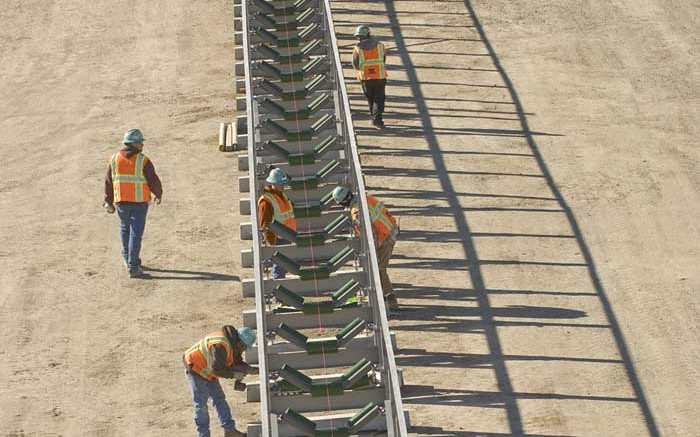Barrick Gold (TSX: ABX; NYSE: ABX) is writing down the value of its assets by US$8.7 billion and slashing its quarterly dividend in response to the recent decline in metal prices.
“I’d like to say how disappointed we are with these charges,” Jamie Sokalsky, Barrick’s president and CEO, said on a conference call discussing the second-quarter results.
The after-tax impairment charges include: US$5.1 billion for the Pascua-Lama gold-silver project in Chile and Argentina, US$2.3 billion in goodwill impairments — of which US$1 billion relates to Barrick’s global copper unit and US$1.3 billion to its Australia Pacific, capital projects and African Barrick segments — and US$1.3 billion in other writedowns, including US$500 million on African Barrick’s assets and US$400 million on the Jabal Sayid copper project in Saudi Arabia.
The impairment tests were completed at long-term price assumptions of US$1,300 oz. gold, US$3.25 lb. copper and US$23 oz. silver to account for the weaker metal prices.
“Despite these writedowns . . . we are confident our assets will generate substantially more economic benefits overtime,” Sokalsky adds.
These writedowns along with the recent $442-million sale of the Barrick Energy division led the miner to swallow a second-quarter net loss of US$8.6 billion, or $8.55 per share, compared to earnings of US$787 million, or US79¢ per share, a year ago.
Excluding those charges and other one-time items, adjusted earnings were US$663 million, or US66¢ per share, beating analysts’ average estimates of US56¢ a share, but below last year’s US82¢ per share.
On a positive note Barrick had a strong operational quarter, producing 1.8 million oz. gold at adjusted operating costs of US$552 per oz. and all-in sustaining costs of US$919 per oz., with both costs coming in below expectations. Copper production totaled 134 million lb. at C1 cash costs of US$1.75 per lb. and C3 fully allocated costs of US$2.27 per lb., as operations at the Lumwana copper mine in Zambia improved.
This led to an adjusted operating cash flow of US$804 million compared to US$919 million in the second quarter of 2012.
As part of the capital allocation framework that Sokalsky implemented last year to review the company’s operations and identify cost-saving measures to increase cash flow, Barrick has cut its capital expenditures in the first quarter by US$500 million and in the second quarter by US$1.5 billion, bringing total reductions to US$2 billion for the first half of 2013, helping offset the impact of the tumbling gold and copper prices this year. (The spot price for gold dropped 25% to around US$1,240 per oz. in the first half of 2013.)
Given the current price environment Barrick is continuing to optimize all its operations and highlights 60% of this year’s gold production will come from its five “superior” mines — Goldstrike and Cortez both in Nevada, Veladero in Argentina, Lagunas Norte in Peru and Pueblo Viejo in the Dominican Republic — at average all-in sustaining costs of US$650 to $700 per oz. At seven of its smaller mines it forecasts average all-in costs of below US$1,000 per oz.
Sokalsky adds the company’s remaining 12 mines with expected all-in costs of over US$1,000 per oz. will face either a revision in mine plan, suspension, closure or divesture to improve free cash flow.
In a move to further boost liquidity, Barrick has cut its quarterly dividend to US5¢ a share from US20¢ a share, providing US$600 million in cost-savings annually. “We recognize the importance of dividends to our shareholders,” Sokalsky says. “But at this time, we believe this is the prudent course of action.”
Barrick is also no longer targeting 8 million oz. gold in 2016, as it focuses on producing low-cost ounces and reining in costs. It has only the Pascua-Lama project in its development pipeline, which has been plagued with cost escalations and construction delays.
Sokalsky admits “some shareholders and analysts have expressed frustration with the project” and have questioned the company’s motive to continue advancing Pascua-Lama in the current price environment.
“While it is true at today’s gold and silver prices, the economics are not as robust as we would need to green-light a new project for development.” It’s much harder to cancel or shelve a project halfway through development versus at the start of construction, Sokalsky says, adding the long-term benefits should outweigh the shorter-term headaches at Pascua-Lama. The mine is slated to become one of Barrick’s core mines and is anticipated to generate 800,000-850,000 oz. gold and 35 million oz. silver in its first full five years of operation.
Currently at the project, the miner is working on completing a water management system by the end of next year to satisfy the requirements of the Chilean regulatory authorities, so it could resume construction, which has been halted since April due to alleged environmental non-compliance. Barrick expects to have ore ready to process from the Chilean side by mid-2016 and, as a result, has slowed the construction of the process plant and facilities in Argentina to meet that production date.
For the full-year of 2013 Barrick forecasts producing 7-7.4 million oz. gold at all-in sustaining costs of US$900-$975 per oz., down from US$1,000-$1,100 per oz. earlier.
It has increased the lower end of its 2013 copper guidance by 20 million to 500-540 million lb. copper, and has revised its C3 fully allocated costs to US$2.50-$2.75 per lb., from US$2.60-$2.85 per lb.


Be the first to comment on "Barrick takes US$8.7B impairment charge"